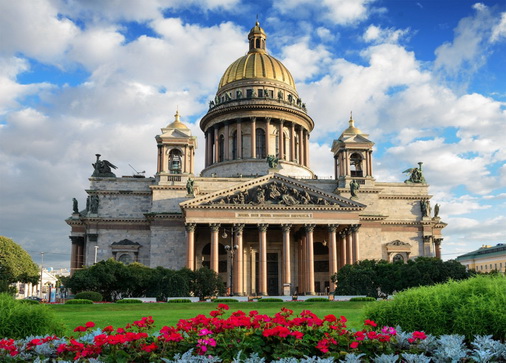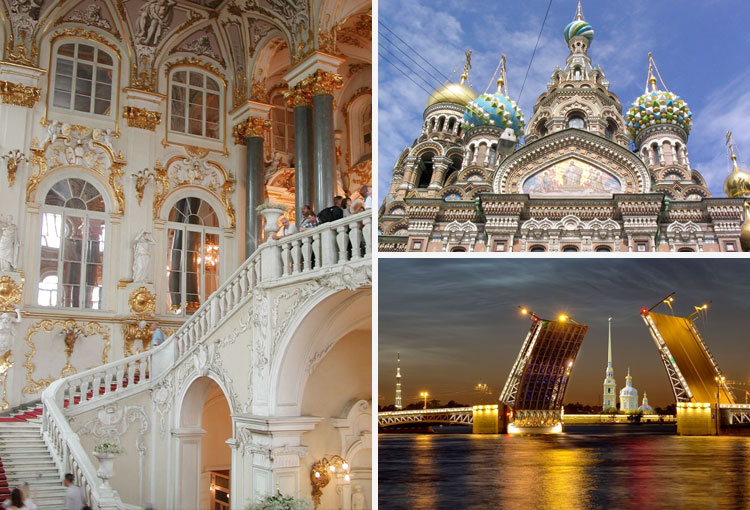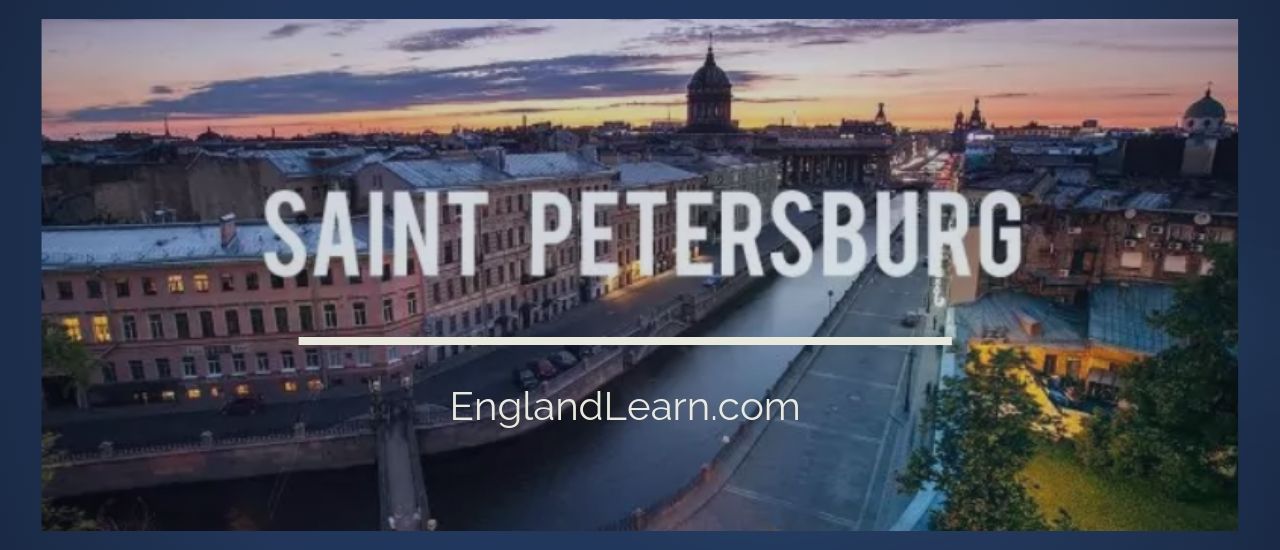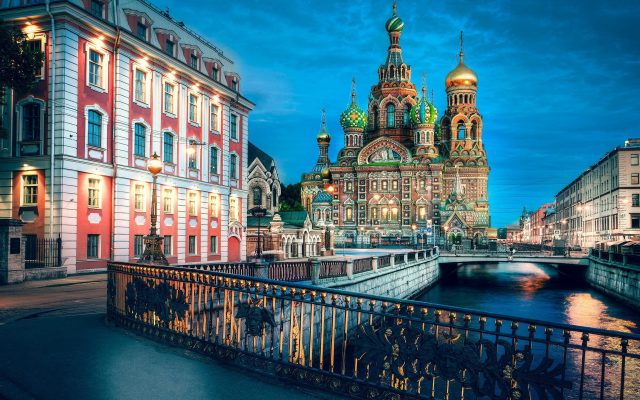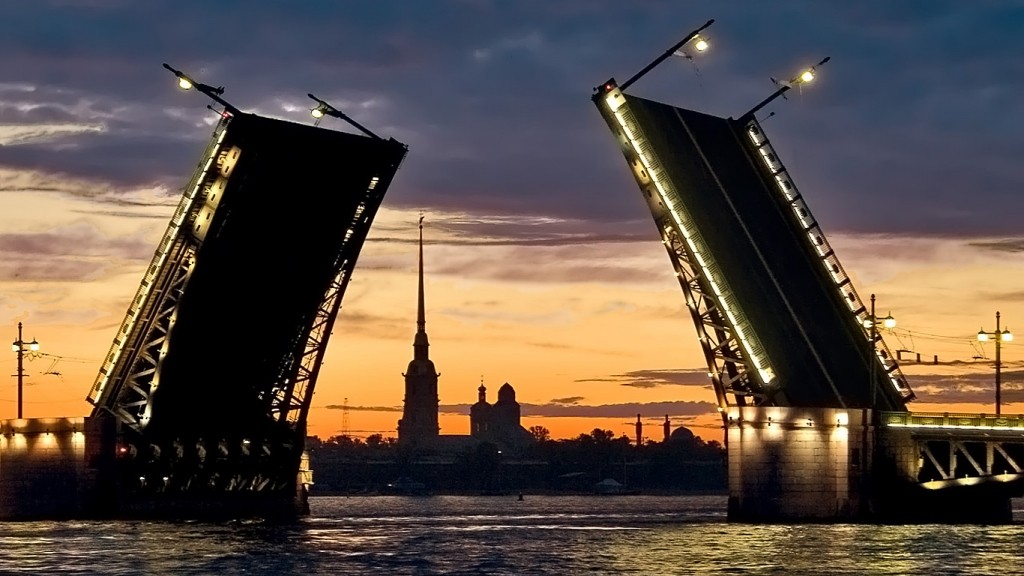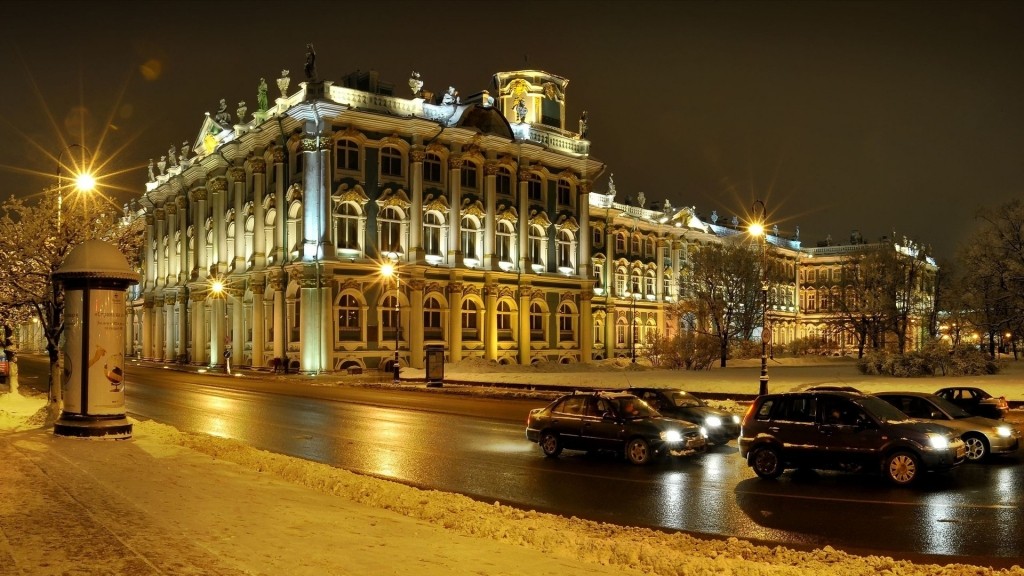St. Petersburg is a Russian port city on the Baltic Sea. It was the imperial capital for 2 centuries, having been founded in 1703 by Peter the Great. The city remains Russia’s cultural center, with its world-famous museums, palaces and theatres.
The Hermitage is one of the largest and oldest museums in the world. It was founded by Catherine the Great. The museum includes masterpieces by Leonardo da Vinci, Picasso, Renoir, Vincent van Gogh, Rembrandt and many others. Experts say it would take 11 years to examine about 3 million exhibits in the Hermitage.
Nevsky Prospekt is the main street in St. Petersburg which was cut through thick woodland in 1718. Kazan Cathedral with its impressive colonnade is located just in the heart of the street. The prospect is lined with numerous cafés, restaurants and shops.
Church of the Saviour on the Spilled Blood with its colourful domes and bright mosaics was constructed in the early 20th century on the spot of the 1881 assassination of Tsar Alexander II. Used by the Soviets to store potatoes during the Second World War 900-day siege of the city by Nazi forces, the church was finally reopened to the public in 1997.
Peter and Paul Fortress was one of the first buildings to be erected in St Petersburg in 1703, including the Baroque Peter and Paul Cathedral, which is the final resting place of almost all of Russia’s pre-revolutionary leaders (Peter the Great, Catherine the Great, Nicholas II and others). Other sights include an impressive statue of Peter the Great named “The Bronze horseman”, a working mint and the cells where revolutionaries were held.
Mariinsky Theatre was first opened in 1860. The theatre has long been one of the world’s most prominent venues for ballet and opera. Its dance school trained such world-famous ballet dancers as Rudolf Nureyev and Vatslav Nijinsky.
While the State Hermitage displays fine art from all over the world, the Russian Museum contains home-grown masterpieces. Opened in 1898, the museum exhibits everything from priceless orthodox icons to paintings by such famous artists as Surikov, Vasnetsov, Aivazovsky, Kandinsky. Among outstanding works are “The Last Day of Pompeii” by Karl Bryullov, and Ilya Repin’s “The Zaporozhye Cossacks Writing a Letter to the Turkish Sultan”.
The gold-domed 19th-century St Isaac’s Cathedral is one of St Petersburg’s most famous landmarks. It offers wonderful views of the city from its gilded viewing platform. Statues of the apostles stand guard at the top of St Isaac’s, while its massive doors are decorated with biblical scenes. Inside, the cathedral boasts a vast ceiling painting by Karl Bryullov as well as St Catherine’s Chapel.
Vasilevskiy Island — the largest island in St Petersburg which offers a bizarre selection of attractions including a pair of 15th-century sphinxes from Egypt on the river side and a museum of biological oddities “Kunstkamera” where you can see the skeleton and the heart of Peter the Great’s gigantic personal servant. The island is also home to the 19th-century Rostral Columns whose torches are lit on special occasions. It’s a great place to wander along the banks of the Neva river.
Перевод
Санкт-Петербург – российский город-порт на Балтийском побережье. В течение двух столетий он оставался государственной столицей, основанной в 1703 г Петром Великим. Город все так же является культурным центром России, с его всемирно известными музеями, дворцами и театрами.
Эрмитаж – один из крупнейших и старейших музеев мира. Он был основан Екатериной Великой. Музей включает в себя шедевры Леонардо да Винчи, Пикассо, Ренуара, Винсента ван Гога, Рембрандта и других. Эксперты утверждают, что потребовалось бы целых 11 лет на изучение 3 миллионов экспонатов Эрмитажа.
Невский проспект – это главная улица Санкт-Петербурга, которая была прорублена сквозь густые леса в 1718 г. Казанский Собор с его впечатляющей колоннадой расположен в самом сердце улицы. Проспект застроен многочисленными кафе, ресторанами и магазинами.
Храм Спаса на Крови с его разноцветными куполами и яркой мозаикой был сооружен в начале 20 века на месте убийства царя Александра II в 1881 г. Используемая советскими властями для хранения картофеля во время 900-дневной блокады города нацистами во время Второй Мировой войны, храм был окончательно открыт для публики в 1997 г.
Петропавловская крепость – одно из первых зданий, возведенных в Санкт-Петербурге в 1703 г, включая Петропавловский собор в стиле барокко, ставший последним пристанищем почти для всех российских дореволюционных глав (Петра Великого, Екатерины Великой, Николая II и других). К другим достопримечательностям относятся впечатляющая статуя Петра Первого под названием «Медный всадник», действующий монетный двор и камеры, в которых держали революционеров.
Мариинский театр был впервые открыт в 1860 г. Долгое время театр является одним из наиболее выдающихся мест проведения балетных и оперных представлений. Его балетная школа выпустила таких всемирно известных балетных танцоров, как Рудольф Нуриев и Вацлав Нижинский.
В то время, как Государственный Эрмитаж представляет произведения изящного искусства со всего мира, Русский музей содержит отечественные шедевры. Открытый в 1898 г, музей представляет все: от бесценных православных икон до полотен таких знаменитых художников, как Суриков, Васнецов, Айвазовский, Кандинский. Среди выдающихся картин можно увидеть «Последний день Помпеи» Карла Брюллова и «Запорожские казаки пишут письмо турецкому султану» Ильи Репина.
Исаакиевский собор 19 века с его золотыми куполами – одна из известнейших визитных карточек Санкт-Петербурга. Он предлагает прекрасную панораму города со своей золоченой обзорной площадки. На крыше собора стоят на посту статуи апостолов, массивные двери украшены библейским сценами. Внутри собор может гордиться огромным расписным потолком, выполненным Брюлловым, а также Часовней Св.Катерины.
Васильевский остров – крупнейший остров в Санкт-Петербурге, предлагающий причудливую коллекцию достопримечательностей, включающих пару египетских сфинксов 15 века на побережье и музей биологических странностей «Кунсткамера», в котором можно увидеть скелет и сердце личного слуги-гиганта Петра Первого. На острове также стоят Ростральные колонны 19 века, чьи факелы зажигаются по особым случаям. Это отличное место для прогулок вдоль берегов реки Нева.
Тема «Санкт-Петербург и его достопримечательности» (St. Petersburg and its attractions) — 4.4 out of
5
based on
69 votes
Представлено сочинение на английском языке Достопримечательности Санкт-Петербурга/ Places of Interest in St Petersburg с переводом на русский язык.
| Places of Interest in St Petersburg | Достопримечательности Санкт-Петербурга |
| Saint Petersburg is the north capital of Russia. It is known as one of the biggest and most beautiful cities of the country. People often call St Petersburg the Venice of the North, because it has as many canals as Venice. | Санкт-Петербург является северной столицей России. Он известен, как один из крупнейших и красивейших городов страны. Люди часто называют Санкт-Петербург Северной Венецией, потому что в нем также много каналов, как и в Венеции. |
| St Petersburg is also the former capital of Russia. It has then moved to Moscow. Millions of people every year visit this city. It happens because of the city’s rich history, amazing architecture and numerous places of interest. | Санкт-Петербург также является бывшей столицей России. Потом она переместилась в Москву. Ежегодно миллионы людей посещают этот город. Это происходит из-за богатой истории города, великолепной архитектуры и множества достопримечательностей. |
| The most famous place which everybody wishes to see is the Hermitage. It’s a huge museum, which houses more than 3 million art items, and is situated in the building of Winter Palace. The first person who started collecting paintings and sculptures of famous European artists was the Empress Catherine II. | Самое знаменитое место, которое все мечтают посетить, это Эрмитаж. Это огромный музей, в котором умещается более 3 миллионов работ искусства, и который расположен в здании Зимнего дворца. Первым человеком, который начал коллекционировать картины и скульптуры известных европейских художников, была императрица Екатерина II. |
| Another big and often visited museum in St Petersburg is the Russian Museum. It holds the biggest collection of Russian art, including paintings, sculptures, items of applied and folk arts. | Другой большой и часто-посещаемый музей в Санкт-Петербурге – это Русский музей. В нем хранится крупнейшая коллекция Российского искусства, включая картины, скульптуры, предметы прикладного и народного искусства. |
| The main architectural sights of St Petersburg are the Savior on the Blood Church, St. Isaac’s and Kazan Cathedrals, Alexander Nevsky Monastery, Peter and Paul Fortress and many others. Many buildings in the city were put up by Peter the Great’s order, who was one of the best rulers of the country. | Основными архитектурными достопримечательностями Санкт-Петербурга являются, церковь Спас на Крови, Исаакиевский и Казанский соборы, Александро-Невская Лавра, Петропавловская крепость и многие другие. Многие здания в городе были возведены по приказу Петра Великого, который был одним из лучших правителей страны. |
| Some attractive sights can be found in the suburbs, such as Peterhof, Pavlovsk, Tsarskoe selo. All these places have once served as the official residences for Russian tsars. And, it goes without saying that there are many magnificent palaces to be seen, such as the Great Yekaterininsky Palace, the Aleksandrovsky Palace, the Bolshoi Palace and some others. Tsarskoe selo was also the place where famous Russian writer, Pushkin, grew up. | Некоторые привлекательные достопримечательности можно найти в пригороде, например, Петергоф, Павловск, Царское село. Все эти места когда-то служили официальными резиденциями русских царей. И, само собой разумеется, там много великолепных дворцов, стоящих увидеть, такие как Большой Екатерининский дворец, Александровский дворец, Большой дворец и некоторые другие. Царское село было также местом, где вырос известный русский писатель Пушкин. |
Санкт Петербург – город, известный во всем мире. На английском языке название звучит как St. Petersburg [сэнт питэсбёг].
Этот город был основан Российским императором Петром Великим.
To be founded [ту би фаундид] – основать;
Peter the Great [питэ зэ грэйт] – Петр Великий;
Peter I [питэ зэ фёст] – Пётр Первый.
Пример диалога:
- What do you know about St. Petersburg?
- As far as I know iIt was founded by Peter I, the first Russian emperor.
- When did he found the city?
- In 1703, but I’m not sure.
- Why did he do it?
- To open the ‘’window to the West”, I think.
Перевод диалога:
- Что ты знаешь о Санкт-Петербурге?
- Насколько мне известно, его основал Пётр I, первый российский император.
- Когда он основал город?
- в 1703, но я не уверен.
- Зачем он это сделал?
- Чтобы открыть окно в Европу, я думаю.
В Санкт-Петербурге вам могут предложить разные виды экскурсий:
- city tour [сити туэ] – обзорная экскурсия по городу;
- walking tour [уокинг туэ] – пешая экскурсия;
- bus excursion [бас икскёшн] – автобусная экскурсия;
- sight-seeing tour [сайтсиинг туэ] – экскурсия с целью осмотра достопримечательностей;
guided tour [гайдид туэ] – коллективная экскурсия; - all-day tour of the city [олдэй туэ оф зэ сити] – экскурсия по города, рассчитанная на весь день;
- night-time excursion [найт-тайм икскёшн] – ночная экскурсия;
To get excursion through [ту гет икскёшн фру] – совершать экскурсию по;
To make a tour of the city [ту мэйк э туэ оф зэ сити] – совершать экскурсию по городу.
Диалог об экскурсии в Петербург на английском языке
- Let’s take a bus tour along St. Petersburg.
- How much does it cost?
- 140 pounds for 2 tickets.
- It’s too expensive for us I’m afraid.
- OK. What about a walking tour? It costs 30 ponds for both of us.
- Very well.
Перевод:
- Давай съездим на автобусную экскурсию по Санкт-Петербургу.
- Сколько это стоит?
- 140 фунтов за 2 билета.
- Боюсь, это слишком дорого для нас.
- Ну хорошо. Как насчет пешей экскурсии, Она обойдется в 30 фунтов за нас двоих.
- Очень хорошо.
Рассказ о Санкт-Петербурге и его достопримечательностях на английском языке
Санкт-Петербург известен многими красивыми местами:
- theatres [феатэз] – театры;
- museums [мьюзиэмз] – музеи;
- churches [чёчиз] – церкви;
- cathedrals [кэфидрэлз] – соборы;
- monuments [моньюментс] – памятники;
- parks [пакс] – парки;
- gardens [гадэнз] – сады;
- channels [чэнэлз] – каналы;
- bridges [бриджиз] – мосты;
- buildings [билдингз] – здания.
Примеры:
St. Petersburg is famous for its numerous theatres, museums, cathedrals and grand buildings. – Санкт-Петербург знаменит бесчисленными театрами, музеями, соборами и величественными зданиями.
Many people are delighted with the beauty of its parks and streets. – Многие люди восхищаются красотой его парков и улиц.
Во время экскурсии можно полюбоваться на следующие достопримечательности города:
The Palace Embankment [зэ пэлэс имбэнкмэнт] – Дворцовая набережная.
- the Neva [зэ нева] – река Нева.
- towers [тауэз] – башни.
We’re in the centre of St. Petersburg and we are walking along the Palace Embankment. You can see the Neva, the bridges and all the towers od the city. – Мы находимся в центре Санкт-Петербурга и проходим по Дворцовой набережной. Вы можете видеть реку Неву, мосты и все башни города.
Senate’s Square [сенэтс скуэа] – Сенатская площадь.
The Bronze Horseman [зэ бронз хосмэн] – Бронзовый всадник.
To be created [ту би криэйтид] – быть созданным.
To present [призэнт] – представлять (что-либо)
Take a look around. It is Senate’s Square and the Bronze Horseman. It was created by a talented sculptor Falconet in 1782 and it presents the statue of Peter the Great on a horseback. Посмотрите вокруг. Это Сенатская Площадь и Бронзовый всадник. Он был создан талантливым скульптором Фальконе в 1782 году и представляет собой статую Петра Великого верхом на коне.
St. Isaac’s Cathedral [сэнт айзэкс кэфидрэл] – Собор святого Исаака (Исаакиевский Собор).
To be decorated [ту би декорэйтид] – быть украшенным.
Now take a look at a magnificent building of St. Isaac’s Cathedral, the third largest cathedral in the world. It was built in 1818-1858 and it is decorated with granite one-piece columns. The Cathedral can hold up to 13000 people. – Сейчас посмотрите на величественное здание Исаакиевского собора, третьего по величине собора в мире. Его строили в 1818-1858 и украсили колоннами из цельного гранита. Собор может вместить до 13000 человек.
Palace Square [пэлис скуэа] – Дворцовая площадь.
Alexander Column [элигзандэ колэм] – Александрийский столп.
Next comes Palace Square with the world’s tallest monument – Alexander Column that is 45.7 m high. It was built in honor of the Russian victory over Napoleon in 1812. – Следующей идет Дворцовая площадь с самым высоким в мире памятником – Александрийским столпом, чья высота 45,7 метров. Он был построен в честь русской победы над Наполеонов в 1812.
The Winter Palace [уинтэ пэлис] – Зимний Дворец.
To face [ту фэйс] – стоять лицом.
Now we are facing the Winter Palace by the architect Bartolomeo Rastrelli. The Hermitage museum, which houses more than 3 million items of art, is situated there. – Сейчас мы стоим лицом к Зимнему дворцу архитектора Бартоломео Растрелли. Музей Эрмитаж, который содержит более 3 млн предметов искусства, располагается там.
Nevsky Prospect [невски проспект] – Невский проспект.
To walk along [ту уок элонг] – идти по
Now we are walking along Nevsky Prospect which is 4.5 km long. Lots of shops, theatres, cafes and restaurants are located here. – Сейчас мы идем по Невскому проспекту, который 4, 5 км в длину. Много магазинов, театров, кафе и ресторанов расположено здесь.
The Russian Museum [зэ рашн мьюзиэм] – Русский Музей.
- Painters [пэйнтэз] – художники.
- And others [энд азэз] – и другие
- For example [фо икзампл] – например.
At the moment you can see the Russian Museum. It was designed by an outstanding architect K.Rossy. This museum places works of many great Russian painters. For example, Rublyov, Repin, Vrubel and others. – В данный момент вы видите Русский музей. Он был спроектирован выдающимся архитектором К.Росси. Этот музей содержит много работ великих русских художников. Например, Рублева, Репина, Врубеля и других.
Санкт-Петербург, без сомнения, является одним из красивейших городов в мире. Он был основан русским царем Петром I, который мечтал построить новую столицу России, конкурентоспособную с другими европейскими столицами. Его мечта была великолепно воплощена в жизнь. Санкт-Петербург полон роскошных дворцов, зданий фантастического архитектурного искусства и исторических музеев.
Санкт-Петербург — один из красивейших в мире городов
St. Petersburg, without a doubt, is one of the most beautiful cities in the world. It was founded by the Russian Tsar Peter the Great, who dreamed of building a new capital of Russia, competitive with other European capitals. His dream was magnificently embodied in life. Saint-Petersburg is full of luxurious palaces, buildings of fantastic architectural art, and historical museums.
Эрмитаж
The Hermitage is the marvellous Russian museum in Saint-Petersburg. The house of the world’s largest collection of art, the Hermitage is definitely worth a visit. It is said that it will take more than 11 years to stand just one minute before each of more than 3 million exhibits. The museum consists of 6 buildings, including the luxurious Winter Palace — an elegant building in the Baroque style. In the endless series of rooms, you can admire some of the greatest masterpieces, including such famous artists as Leonardo Da Vinci, Picasso, and Rembrandt. If you have a passion for the history of art or architecture, or if you just want to explore the most interesting landmarks of Saint-Petersburg, then the Hermitage should not be overlooked.
Эрмитаж — это великолепный русский музей в Санкт-Петербурге. Дом крупнейшей в мире коллекции искусства, Эрмитаж, безусловно, стоит посетить. Говорят, что потребуется более 11 лет, чтобы постоять всего одну минуту перед каждым из более чем 3 миллионов экспонатов. Музей состоит из 6 зданий, в том числе роскошного Зимнего дворца — элегантного здания в стиле барокко. В бесконечных сериях комнат вы можете полюбоваться на некоторые из величайших шедевров, в том числе таких известных художников, как Леонардо Да Винчи, Пикассо и Рембрандта. Если у вас есть страсть к истории искусства или архитектуры, или вы просто хотите исследовать самые интересные достопримечательности Санкт-Петербурга, то Эрмитаж не следует упускать из виду.
Соборы Санкт-Петербурга
Saint-Petersburg is also home to some magnificent churches, such as Saint Isaac’s Cathedral, which was built for 40 years. A dazzling golden dome of the cathedral can be seen for miles. You can not also miss the colourful «Church of the Savior on Spilled Blood» with its onion domes, mosaics, and spires. This elaborate building is like something from a Russian fairy tale.
В Санкт-Петербурге также есть несколько великолепных церквей, таких как Исаакиевский собор, который строился в течение 40 лет. Ослепительный золотой купол собора можно увидеть за мили. Вы также не можете пропустить красочную «Церковь Спасителя на Крови» с ее луковыми куполами, мозаикой и шпилями. Это сложное здание похоже на что-то из русской сказки.
Екатерининский дворец
Along with eye-catching churches, Saint-Petersburg is renowned for its majestic palaces such as the stunning Catherine Palace with its striking white and blue facade stretching for nearly 1,000 feet. This is one of the world’s largest palaces. The palace was loved by Catherine the Great who would arrange extravagant costume balls in the Great Hall. They say she had fifteen thousand dresses, and she never put on the same one again.
Наряду с привлекательными церквями, Санкт-Петербург славится своими величественными дворцами, такими как потрясающий Екатерининский дворец с ярким бело-голубым фасадом, простирающимся почти на 1000 футов. Это один из крупнейших в мире дворцов. Дворец был любим Екатериной Великой, которая устраивала экстравагантные костюмированные балы в Большом зале. Говорят, у нее было пятнадцать тысяч платьев, и она никогда не надевала одно и то же снова.
Петергоф
Another of the remarkable palaces of St. Petersburg is Peterhof, built on the orders of Peter the Great as Versailles rival in France. The palace is surrounded by French and English gardens with a magnificent grandiose cascade, which is an exciting centre.
Еще одним из замечательных дворцов Санкт-Петербурга является Петергоф, построенный по приказу Петра Великого как соперник Версаля во Франции. Дворец окружен французскими и английскими садами с великолепным грандиозным каскадом, который представляет собой захватывающий центр.
Saint-Petersburg is an impressive and fascinating city, which, like no other, will remain in your memory for a long time.
Санкт-Петербург — впечатляющий и увлекательный город, который, как никакой другой, надолго останется в вашей памяти.
Санкт Петербург – город, известный во всем мире и вызывающий восхищение своей архитектурой, историческими памятниками и культурой. Туристы стекаются в него со всего мира, центр города постепенно становится мульти язычным, в кафе все чаще можно найти английское меню. Мы не будем отставать от общей тенденции и разберем основную лексику про Санкт-Петербург на английском языке.
Содержание
- Перевод названия
- Выражения с переводом по теме Санкт Петербург
- Рассказ о Санкт-Петербурге на английском языке
Перевод названия
Имена собственные никогда не переводятся, для передачи названия используется смешанный метод транслитерации и транскрибирования.
Забавный факт в том, что само название города Санкт-Петербург уже не исконно русское, и хотя и было создано в честь Святого Петра (St Petersburg — город Святого Петра), но приглашенными Петром Первым иностранными специалистами записывалось и озвучивалось на свой лад. В результате название закрепилось в немецком варианте. Поэтому в английском языке писать St Petersburg или Saint Petersburg правильно, Sankt Petersburg как немецкий вариант остается для немцев. Такой вот интересный языковой парадокс произошел с названием этого города.
На английском языке название звучит как:
- St. Petersburg,
- Saint-Petersburg,
- St Petersburg,
- Saint Petersburg,
- St.-Petersburg,
- St.Petersburg
В американских, австралийских и британских географических атласах встречаются только два названия для Петербурга, это «St. Petersburg» или «Saint Petersburg». Sankt Petersburg, как правильно уже было замечено, вариант неправильный.
В английском языке нет широкого распространения в употреблении дефисов и тире. Поэтому название города в этом случае принято писать с пробелом.
Например, английское слово New York на русском языке будет писаться как «Нью-Йорк» с дефисом, New Hampshire – как «Нью-Хэмпшир», New Jersey – как «Нью-Джерси», Rhode Island превращается в русский «Род-Айленд», а знаменитый Los Angeles – в «Лос-Анджелес».
Выражения с переводом по теме Санкт Петербург
- St. Petersburg has a distinctive culture that blends the best elements of various ethnic traditions. – Санкт-Петербург имеет особую культуру, органично соединяющую лучшие компоненты разных этнических традиций.
- A car ferry has been opened linking St. Petersburg and Kaliningrad with German ports. – Открыта паромная переправа, соединяющая Санкт-Петербург и Калининград с портами Германии.
- Moreover Saint-Petersburg is the second largest Russian city with a population of almost five million people. – Сейчас Санкт-Петербург – второй по величине город России с пятью миллионным населением.
You live in St. Petersburg. – Ты живешь в Санкт-Петербурге. - St. Petersburg is a great place in early summer, when the “White Nights” bathe the city’s imperial palaces and avenues. – Санкт-Петербург – прекрасное место в начале лета, когда “Белые Ночи” заливают светом императорские дворцы и проспекты города.
- Still my health did not let me go and study in FSB secret service academy in St Petersburg as I wanted. – Но все-таки здоровье не позволило мне пойти учиться в академии ФСБ в Санкт-Петербурге, как я хотел.
- Eight years ago the remains of the Romanov family were publicly buried in the Peter-Paul castle in Saint Petersburg. – Восемь лет назад останки семьи Романовых были всенародно похоронены в Петро-Павловской крепости в Санкт-Петербурге.
Рассказ о Санкт-Петербурге на английском языке
Saint Petersburg is the second largest city in Russia with a population of 4.6 million people. It is situated on the Neva River at the head of the Gulf of Finland on the Baltic Sea. The city’s other names were Petrograd and Leningrad.
The city was founded by Tsar Peter 1 in 1703. Since that it was the capital of the Russian Empire until 1918.
Saint Petersburg is a very important port on the Baltic Sea. It is also a major financial and industrial centre of Russia specialising in oil and gas trade, shipbuilding yards, aerospace industry, radio and electronics, software and computers; machine building, mining, metallurgy, chemicals, publishing and printing, food and catering and many other businesses.
Saint Petersburg is one of the most beautiful cities in the world. It is a grand European cultural centre. Saint Petersburg is often called “the Venice of the north”. There are a great number of theatres, operas and more than 200 museums in Saint Petersburg. The largest one is the Hermitage Museum which contains the richest collection of pictures and pieces of applied art in the world. Among other notable museums are the Russian Museum, devoted to the Russian fine art, the Kunstkamera, the Central Naval Museum, Saint Petersburg Museum of History, Zoological Museum and Artillery Museum. The most popular theatres are Mariinsky Theatre and The Alexander Theater.
There are numerous parks and gardens in the city. The largest park is Sosnovka and the oldest one is the Summer Garden, which is famous for its cast iron railing and marble sculptures. Among other parks are Maritime Victory Park, the Moscow Victory Park and the Central Park of Culture and Leisure. Saint Petersburg Botanical Garden hosts an important dendrological collections dating back to the 19th century.
Saint Petersburg is famous for its legendary beautiful white nights. The city attracts tourists from all over the world.
Перевод
Санкт Петербург – второй крупнейший город России с населением в 4,6 миллиона человек. Он расположен на реке Нева в верней части Финского залива Балтийского моря. Другими названиями города были Петроград и Ленинград.
Город был основан царем Петром 1 в 1703. С того времени и до 1918 года он был столицей Российской империи.
Санкт Петербург — очень важный порт Балтийского моря. Он также значимый финансовый и промышленный центр России, специализирующийся на торговле нефтью и газом, кораблестроении, аэрокосмической промышленности, радио и электронике, программном обеспечении и компьютерах; машиностроении, горном деле, металлургии, химии, издательстве и печати, ресторанном бизнесе и многом другом.
Санкт Петербург – один из самых красивых городов в мире. Это огромный европейский культурный центр. Санкт Петербург часто называют «Северной Венецией». В Санкт Петербурге большое количество театров, опер и более 200 музеев. Самый большой – это Эрмитаж, имеющий богатейшую в мире коллекцию картин и изделий прикладного искусства. Среди других известных музеев — Русский музей, посвященный русскому искусству, Кунсткамера, музей Навигации, Санкт Петербургский исторический музей, Зоологический музей и музей Артиллерии. Самые популярные театры – Мариинский и Александрийский.
В городе есть многочисленные парки и сады. Самый большой из них – Сосновка, а самый старый – Летний Сад, известный своей чугунной оградой и великолепными скульптурами. Среди других парков выделяют Морской парк Победы, Московский парк Победы и Центральный парк культуры и отдыха. Санкт Петербургский Ботанический Сад содержит важную дендрологическую коллекцию, датируемую 19 веком.
Санкт Петербург славится легендарными красивыми белыми ночами. Этот город привлекает туристов со всего мира.
Сочинение о других городах России можете найти здесь: Мой город – сочинение на английском языке
Продолжая тему знаменитых российских городов познакомьтесь с достопримечательностями Москвы на английском языке. Ведь достопримечательности и историю возникновения названия города Санкт-Петербург на английском языке Вы уже знаете!
Top 20 St. Petersburg attractions and experiences
St. Petersburg has a true wealth of attractions and experiences to offer travelers, from spectacular Imperial palaces to quirky and absorbing museums, from boat trips along the city’s majestic rivers and canals to walks in the footsteps of St. Petersburg’s literary and artistic greats.
In fact, there’s more than enough to see and do in St. Petersburg to keep visitors entertained for weeks or even months. One of the biggest challenges for independent travelers is to work out what they will actually have time to fit in to their itinerary, particularly as St. Petersburg is one of Europe’s largest cities, with the historical centre alone covering several square kilometers and some of the most famous attractions located far out in the suburbs. To help you get the most out of your time in St. Petersburg, our travel writers have drawn on their own expertise and years of feedback from travelers to compile this Top 20 list of attractions and experiences.
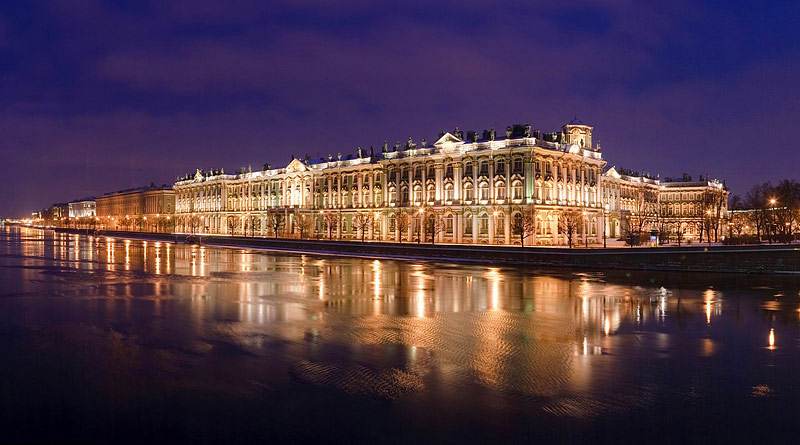
Undoubtedly St. Petersburg’s most famous visitor attraction, and universally acknowledged as one of the world’s greatest treasuries of art and antiquities, the Hermitage is a name to be conjured with, and reason enough on its own for many travelers to book a trip to St. Petersburg.
The Hermitage Museum now spans several sites, but for most visitors it is the main collection in the Winter Palace that is an essential component of any St. Petersburg itinerary. Here you’ll find not only centuries of European fine art and a rich collection of Greek and Roman antiquities, but also the astonishingly opulent 18th and 19th century state rooms of Russia’s imperial family.
Since the summer of 2014, much of the Hermitage’s renowned collection of impressionist and post-impressionist art (in terms of artistic quality, undoubtedly the highpoint of the collection) has been transferred across Palace Square to the General Staff Building, so if your main reason for visiting the Hermitage is to see the art, then you have to consider making time for the second location, possibly with a break for refreshments between the two.
Time
Optimal: One day for the Winter Palace and General Staff Building collections.
Minimum: Two hours
Further reading
Explore the Hermitage: An introduction to St. Petersburg’s greatest museum.
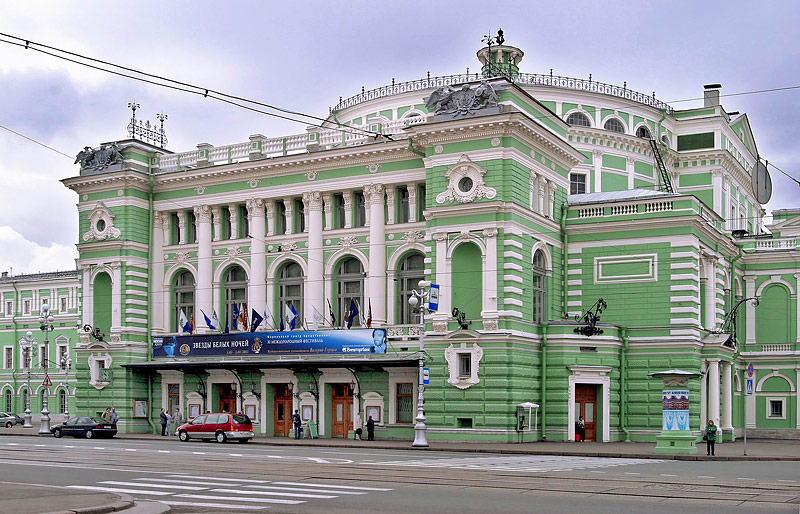
St. Petersburg’s other internationally renowned cultural institution, and for some visitors an even greater draw than the Hermitage, the Mariinsky Theatre has profited in recent years from the financial and creative turmoils of Moscow’s Bolshoi to become the undisputed preeminent musical theatre in modern Russia.
Renowned for the impeccable discipline and devotion to tradition of its ballet company, and blessed in Valery Gergiev with one of contemporary classical music’s most exciting and exacting conductors, as well as international stars of ballet and opera including Ulyana Lopatkina, Diana Vishneva and Anna Netrebko, the Mariinsky Theatre is a world-class venue for ballet, opera and orchestral music.
Recent years have seen the Mariinsky spread beyond its historic home, the wedding-cake late-19th century opera house on Teatralnaya Ploshchad («Theatre Square»), with the addition in 2006 of the Mariinsky Concert Hall, and in 2013 the long-awaited opening of the second opera and ballet stage, Mariinsky II. While most visitors will want to enjoy the rich atmosphere and ornate interiors of the main theatre, both new venues are beautifully designed inside, with state-of-the-art acoustics and stage technology, making them well worth exploring for music enthusiasts.
Time
Optimal: As many performances as time and your budget will allow.
Minimum: At least one evening performance at the Mariinsky should be an essential component of any Petersburg itinerary.
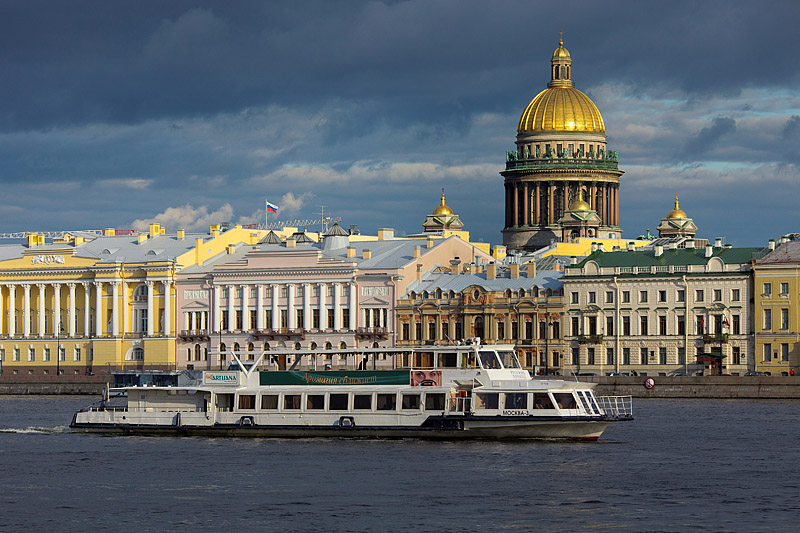
If you’re visiting St. Petersburg from May to October, there are a number of ways to explore the city by boat, from taking the hydrofoil to the suburban palace and park at Peterhof to enjoying dinner and live jazz on an evening cruise along the Neva. When the weather’s good, visitors should really take any opportunity to get out on the water, but even the shortest visit to St. Petersburg in summer should include one boat trip along the city’s central rivers and canals.
There is a wide range of different offers available at the various quays on or near Nevsky Prospekt, with larger boats offering guided tours (some in English) and on-board refreshments, and smaller boats that you can rent by the hour, choose your own route, and bring your own food and drink. All routes through the centre take in some portion of the Fontanka and Moyka Rivers and the Griboedov and Kryukov Canals. Some also head out onto the River Neva, while around midnight most of the boats in the city offer the chance to watch the opening of the Neva’s bascule bridges from the water. Whatever route you end up taking, a boat trip is a fantastic way to see St. Petersburg from a different angle, and perhaps the best possible means of getting an impression of the sheer scope of the city’s architectural beauty and romance.
Time
Optimal: If you’re in the city for more than a few days, it’s definitely worth taking two trips — one sightseeing tour through the centre and one to watch the bridges opening.
Minimum: A basic sightseeing tour along the rivers and canals of the centre will take just over an hour.
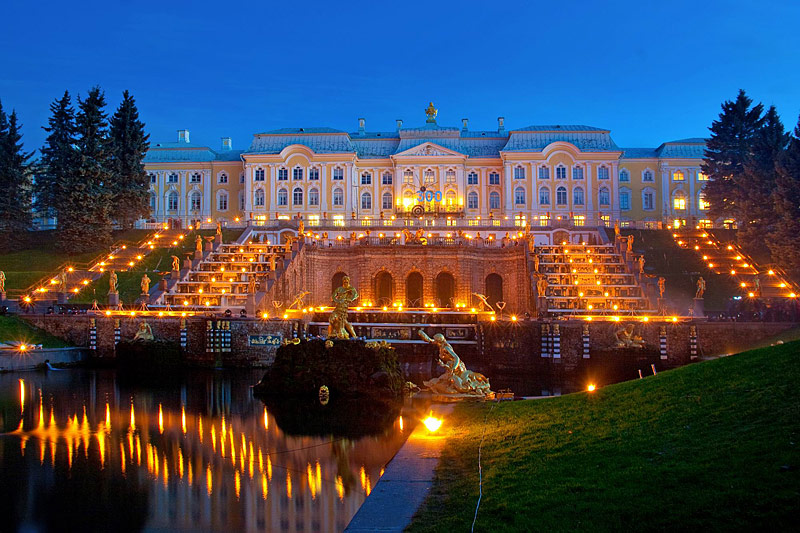
When it comes to visitor attractions, St. Petersburg is as famous for the Imperial palaces and parks in the suburbs as for the museums and palaces in the city centre. Among the former, Peterhof is the one we would class as absolutely unmissbale, especially in summer when the park’s incredible collection of fountains is in operation.
It took Peter the Great over a decade and a few false starts before he found the right site for his summer residence. Modelled partly on Versailles, but with many features that reflected Peter’s specific tastes and interests, the park was expanded under Peter’s daughter, Empress Elizabeth, to greatly surpass its French antecedent in scope and grandeur. While the Grand Palace at Peterhof is less spectacular than the Catherine Palace at Tsarskoye Selo, Peterhof excels in the diversity and range of its attractions, from the charming baroque buildings of the Petrine era to the extraordinary gilded extravagance of the Grand Cascade to the catalog of gardening styles encompassed in the Upper and Lower Parks to the ever-growing number of museums housed in the various buildings on the estate.
Time
Optimal: There is plenty at Peterhof to keep you occupied for a whole day, and the Lower Park is a great place to picnic in the summer.
Minimum: As the journey from the city centre takes at least 45 minutes, half a day is the minimum time necessary to visit Peterhof even for the briefest overview.
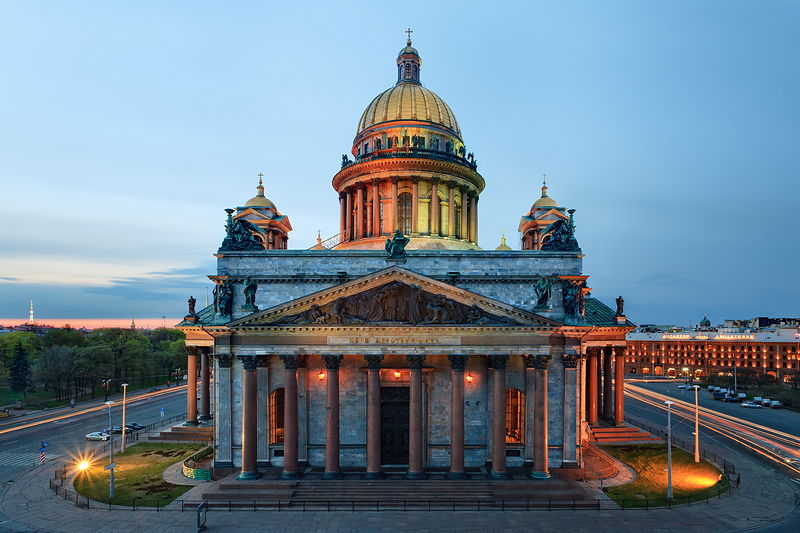
The low-rise skyline of St. Petersburg’s historic centre is dominated by the grand gold dome of St. Isaac’s Cathedral, the life’s work of French architect Auguste de Montferrand and the city’s largest and most spectacular religious building.
Completed in 1858, St. Isaac’s took over forty years to build and decorate. Its strictly European Empire-style facades and colonnades are made unique by the employment of red Karelian granite, while the interiors also meld Orthodox tradition with Catholic influence and extraordinary extravagance in the choice of materials. Different types of semiprecious stone from all over Russia form the interior walls and columns, while an abundance of original art and sculpture goes only a little way to filling the vast hall of the cathedral, designed to accommodate 14 000 standing worshipers. As well as visiting the Cathedral interiors, travelers can buy an extra ticket to climb the 300 steps up to the colonnade. From here, you can enjoy some of the best views of St. Petersburg available.
Time
Optimal: A tour of the cathedral and colonnade should take around two hours. It’s certainly worth getting an audio guide for the cathedral, and possibly for the colonnade if you are entirely unfamiliar with the lay-out of the city.
Minimum: While visiting the cathedral interiors is hardly essential if you have limited time to explore the city, the colonnade is just about the only accessible place in St. Petersburg where you can enjoy something like aerial views of the downtown, so it’s well worth taking half an hour to visit.
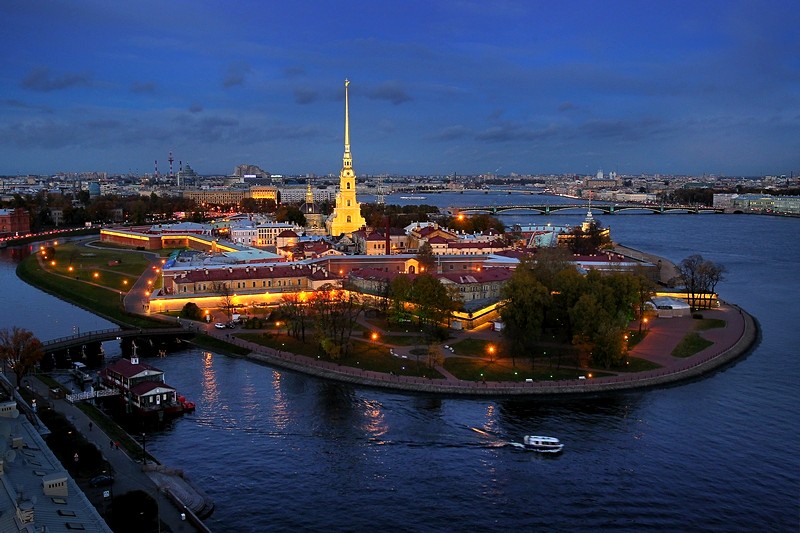
The place where the city of St. Petersburg began, the Peter and Paul Fortress never actually saw military action, but has fulfilled a variety of functions over its three-century history, from burial place for nearly all of the Romanov Emperors and Empresses to notorious political prison to the site of key experiments in the development of Soviet rocket technology. All of these aspects of the fortresses history are celebrated in diverse exhibitions across various buildings, and it is the ramshackle charms of these various museums and collections as much as the grandeur of the spectacular Ss. Petersburg and Paul Cathedral that make the fortress an essential visitor attraction.
Time
Optimal: It’s possible to spend the best part of a full day at the Peter and Paul Fortress, and if possible you should definitely take the time (around five hours) to visit the Peter and Paul Cathedral, explore the displays on the History of St. Petersburg in the Commandant’s House and at the Museum of Cosmonautics and Rocket Techonolgy, and walk along the top of the curtain wall.
Minimum: If you’re short of time, it’s probably enough to pop inside the Cathedral and walk the ramparts (just over an hour).
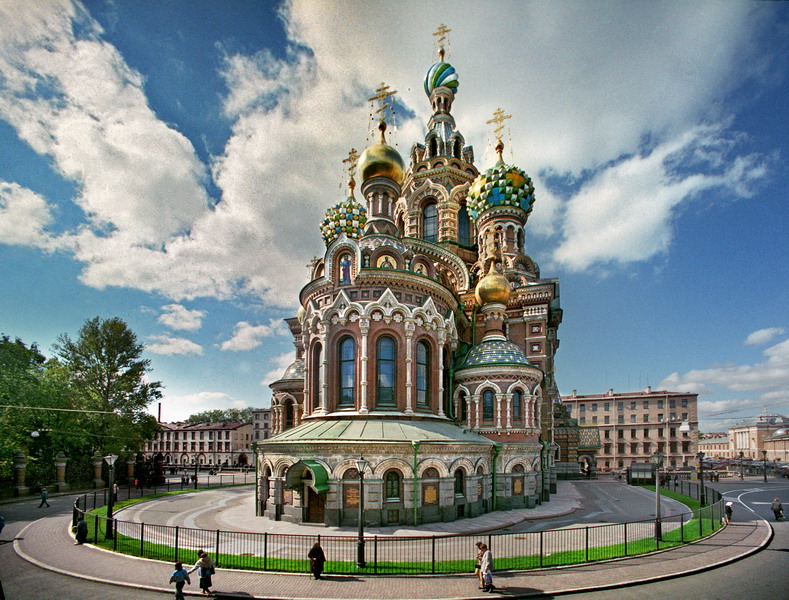
While it lacks the authentic medieval charm of St. Basil’s in Moscow, the Church on Spilled Blood is nonetheless one of St. Petersburg’s most instantly recognizable landmarks, its riotously colorful Russian Revival architecture making a stark contrast to the elegant neoclassicism of the State Russian Museum next door. This is part of the church’s charm, in that it serves to constantly remind the visitor to St. Petersburg that, despite the Italianate elegance of most of the «Golden Triangle», you are still definitely in Russia. It’s extraordinary also that a monument to mark such a tragic event (the assassination of Alexander II) should be so exuberantly colorful.
Time
Optimal: As gaudy and colorful on the inside as on the outside, the Church on Spilled Blood is worth going inside if you have time to listen through an audio guide with the story of the church’s construction (just over an hour in total).
Minimum: If you’re on a whistlestop tour, there’s no need to set aside time for the Church on Spilled Blood, as you’re bound to pass it more than once in even the shortest exploration of St. Petersburg.
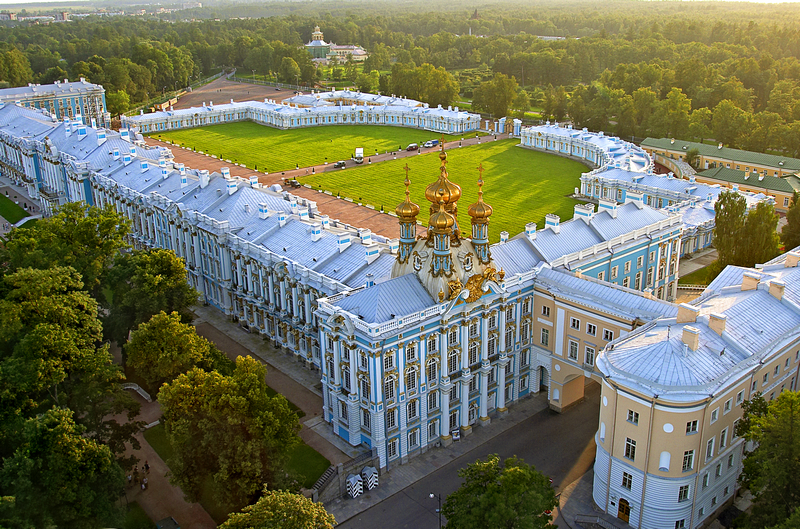
Home to not one but two vast 18th century palaces, surrounded by beautifully landscaped parkland with a rich variety of follies and monuments, Tsarskoye Selo is a testament to the immense wealth and lavishness of the Romanov Imperial family. The rococo Catherine Palace by Bartolomeo Rastrelli, a sister building to his Winter Palace in the city centre, is the most famous attraction, particularly thanks to the extraordinary Amber Room, but there are many other highlights to see, with almost every great St. Petersburg architect of the 18th and early-19th centuries contributing something to the ensemble.
Time
Optimal: Like Peterhof, Tsarskoye Selo is best enjoyed at a leisurely pace over a full day, with a break for a picnic in the park or lunch at one of Pushkin’s restaurants.
Minimum: There’s no point in visiting Tsarskoye Selo unless have a full morning or afternoon free. It’s all worth considering combining Tsarskoye Selo with the palace and park at Pavlovsk a few kilometers east. This also gives you the opportunity to dine at the excellent Podvorye restaurant.
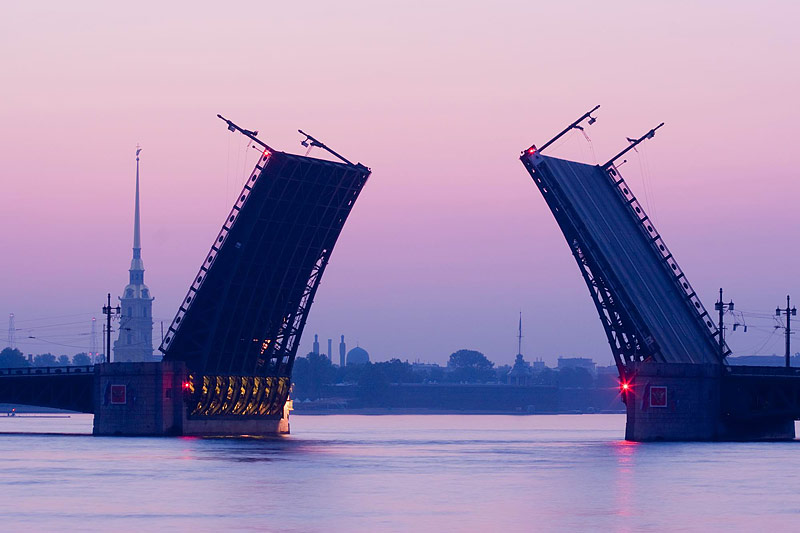
The Neva River connects Lake Ladoga to the Baltic Sea, and during the summer navigation season tens of cargo ships per day follow this important route, making it necessary to open the bascule bridges across the Neva in central St. Petersburg. This is done after midnight, and during the White Nights especially it has long been a tradition for crowds to gather along the embankments to watch the raising of the bridges. The raised arches of Palace Bridge make for one of St. Petersburg’s most famous views, but its as much the atmosphere of lazy revelry and contentment inspired by the eternal twilight that makes this such an unmissable St. Petersburg experience.
Time
Optimal: If you have the opportunity, then it’s worth taking a midnight boat trip out to watch each bridge rise from the water.
Minimum: It is only really Palace Bridge and Trinity Bridge that gather big crowds, and they are undoubtedly the most beautiful. To watch the two adjacent bridges rising and walk the kilometer along the river between the two is a pleasant way to spend an hour before bed.
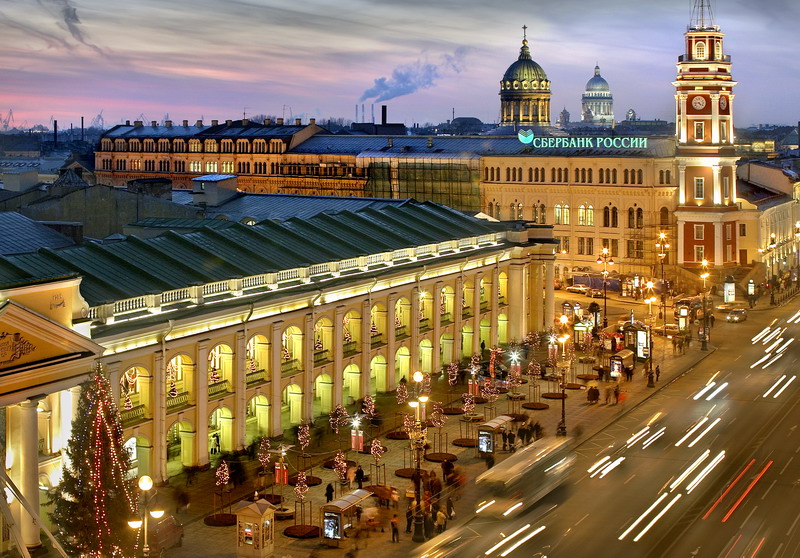
«There’s nothing finer than Nevsky Prospekt, at least not in St. Petersburg.» So begins Nikolay Gogol’s famous tale of St. Petersburg’s central avenue. While that story may end in disillusion and despair, there’s little doubt that Nevsky is one of the world’s greatest streets. Running 4.5 kilometers from the Admiralty in the west to the Alexander Nevsky Monastery in the east, Nevsky Prospekt has a hardly single building dating from after 1917. Highlights include the magnificent Art Nouveau Singer Building, the baroque Stroganov Palace, Kazan Cathedral with its curved neoclassical colonnade, the Horse Tamers statues on Anichkov Bridge, and the 18th century shopping arcade Gostiny Dvor.
Nowadays, St. Petersburg’s most exclusive shopping area is actually the eastern end of Nevsky, beyond Ploshchad Vosstaniya. As well as landmark buildings and up-market boutiques, however, Nevsky Prospekt also offers an electric atmosphere and energy. Especially in summer, Nevsky is bustling no what the hour, and an increasing number of bars and cafes without outdoor seating give you a better opportunity to enjoy the avenue’s living theatre.
Time
Optimal: It will take at least two hours to walk the full length of Nevsky Prospekt, allowing for brief contemplation of the major sights and attractions.
Minimum: The most famous landmarks on Nevsky are nearly all in the stretch that runs through St. Petersburg’s «Golden Triangle» from the Fontanka River to the Admiralty. This section of the avenue can be explored in around 30 minutes.
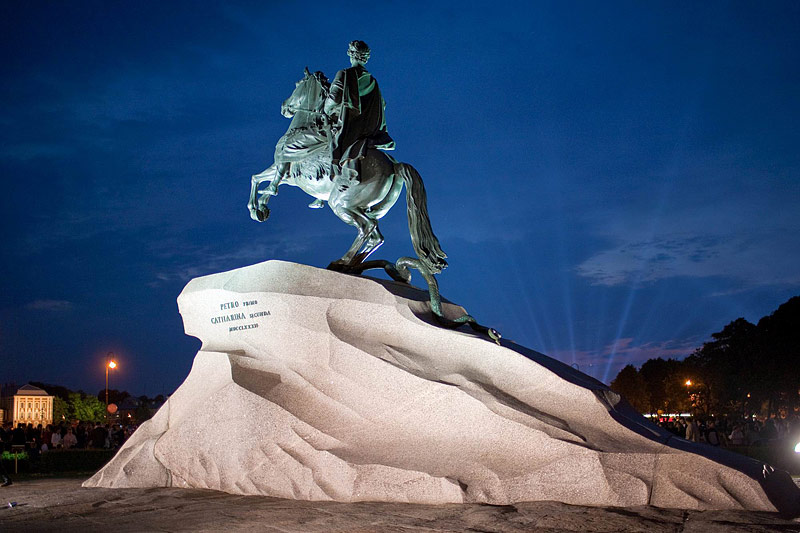
St. Petersburg’s most famous public monument, this equestrian statue to Peter the Great is not only one of the most instantly recognizable symbols of St. Petersburg — like the Statue of Liberty for New York or the Eiffel Tower for Paris — it is also the subject of one of the greatest poems in the Russian language, Alexander Pushkin’s The Bronze Horseman: A Petersburg Tale. Completed in 1782, the statue took 12 years of work by the French sculptor Étienne Maurice Falconet, recommended to Catherine the Great by Denis Diderot himself. The pedestal of the monument, the «Thunder Stone», is purportedly the largest ever moved by man.
Time
The Bronze Horseman is easily combined with a visit to St. Isaac’s Cathedral, so does not require a specific time on your itinerary.
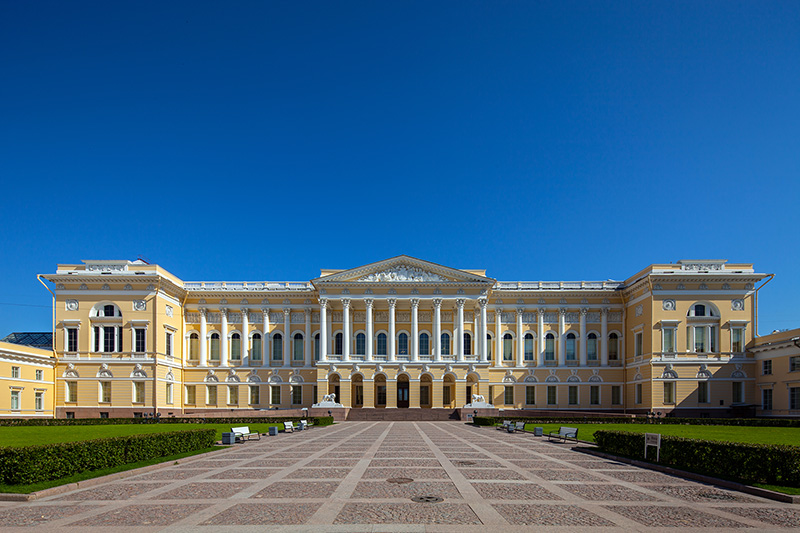
While the Tretyakov Gallery in Moscow is undoubtedly the finest collection of Russian art in the world thanks to its beautiful premises and rich collection of 20th century work, it is matched up to the October Revolution almost painting for painting by the State Russian Museum. Occupying the magnificent Mikhailovsky Palace, the Russian Museum’s main collection is a treasury of Russian visual from throughout the ages, with highlights including medieval icons, atmospheric late-19th century genre paintings, and several modernist masterpieces.
Time
Optimal: The main collection in the Mikhailovsky Palace will take 2-3 hours to do justice to, and it’s also worth visiting the collections in the Marble Palace both to see this beautiful building and for the Peter Ludwig collection of international Pop Art.
Minimum: While the Russian Museum is definitely one of St. Petersburg’s top visitor attractions, if you are on a first-time trip to Russia and visiting Moscow as well, it makes sense to choose either the Russian Museum or the Tretyakov Gallery, as the two have very similar content right down to different variations of the same work in some cases.
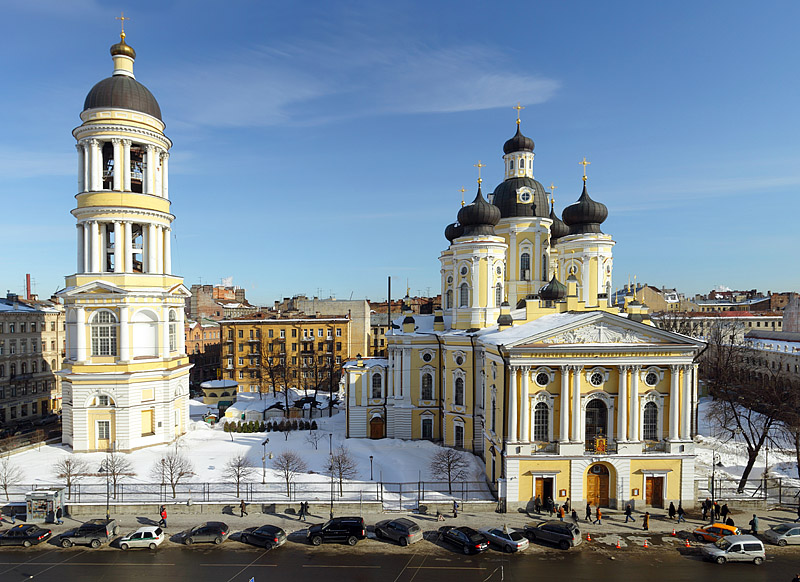
While nearly every great figure of Russian literature spent some time in St. Petersburg, and many wrote works with St. Petersburg as their setting, none is so inextricably linked with the geography and atmosphere of the city as Fyodor Dostoevsky. For many travelers, it is reading his works that sparks an initial desire to visit St. Petersburg, even though his descriptions often make the city monstrous and forbidding. As St. Petersburg’s historic centre has been comparatively untouched by change in the 20th century, much of Dostoevsky’s Petersburg is still there to explore, and the areas around Sennaya Ploshchad and Vladimirskaya Ploshchad are rich in sights connected to his life and works.
Time
Optimal: Our Dostoevsky walking tour takes 3.5 hours, including a visit to the Dostoevsky Memorial Museum.
Minimum: To get an idea of where Dostoevsky lived, you can just visit the museum and the adjacent Church of the Vladimir Icon, as well as the Monument to Fyodor Dostoevsky, in about an hour.
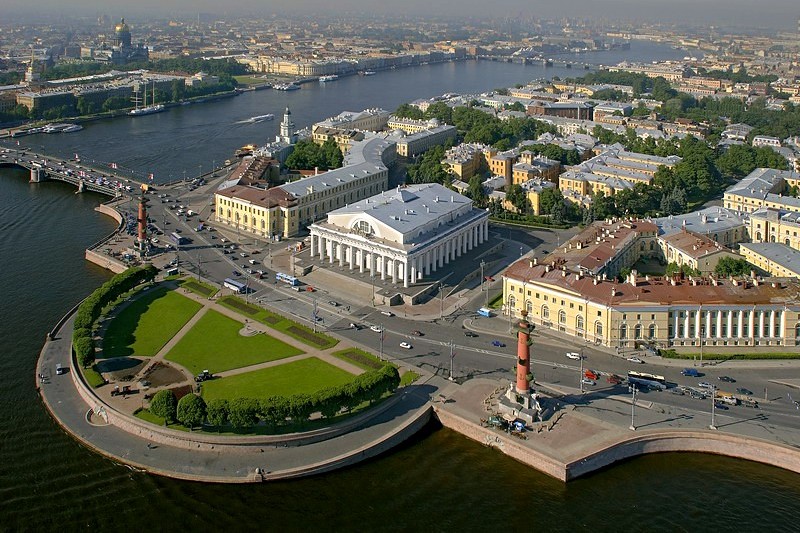
A small promontory of land at the eastern end of Vasilevskiy Island, the Strelka («Spit») is right in the middle of the Neva River Delta, with magnificent views on all sides, including the Winter Palace, Palace and Trinity Bridges, the Peter and Paul Fortress and St. Isaac’s Cathedral. A perennially popular site for wedding parties and bus tours to stop and take photos, the Strelka also has landmarks of its own, specifically the magnificent Rostral Columns, with their gas beacons lit for public holidays and maritime anniversaries, and the elegant classical temple of the St. Petersburg Stock Exchange, all works of the French-born architect Thomas de Thomon.
Time
The Strelka is an integral part of any exploration of Vasilevskiy Island, and does not require separate time on your itinerary.
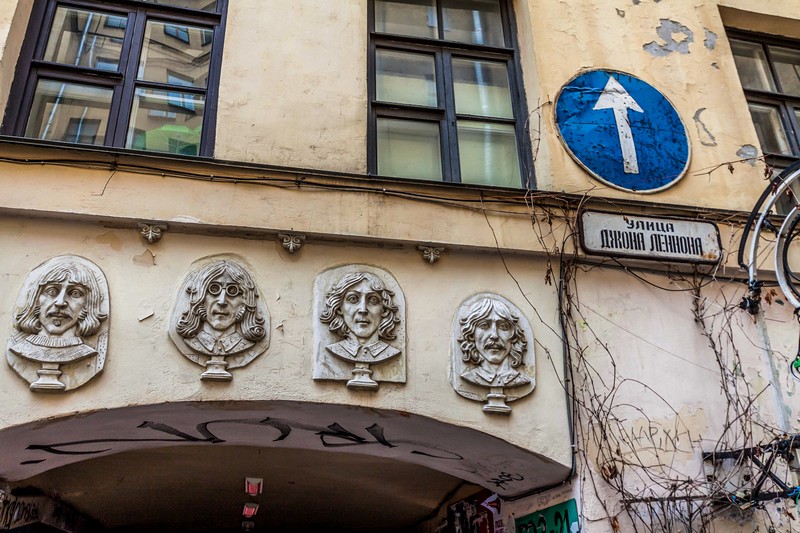
Established in 1989 as a squat for independent artists, alternative musicians, and other «underground» types, Pushkinskaya 10 is an arts and performance centre in an old apartment building a short walk from Nevsky Prospekt. A warren of studios and exhibition space haphazardly linked together as the Museum of Non-Comformist Art, Pushkinskaya 10 can be somewhat bewildering for visitors, and much of the space is often inexplicably closed (the two bars, both of which are also concert venues, are by far the most accessible parts of the complex), but it’s well worth visiting for the increasingly rare chance to get a glimpse of the old Leningrad bohemia and its once revered dissident art scene.
Time
Optimal: The best way to visit Pushkinskaya 10 is to come in the early evening and hope that the galleries are open, before heading to one of the two music venues for a concert.
Minimum: A 15-minute visit should suffice to get an overall impression of the center’s atmosphere.
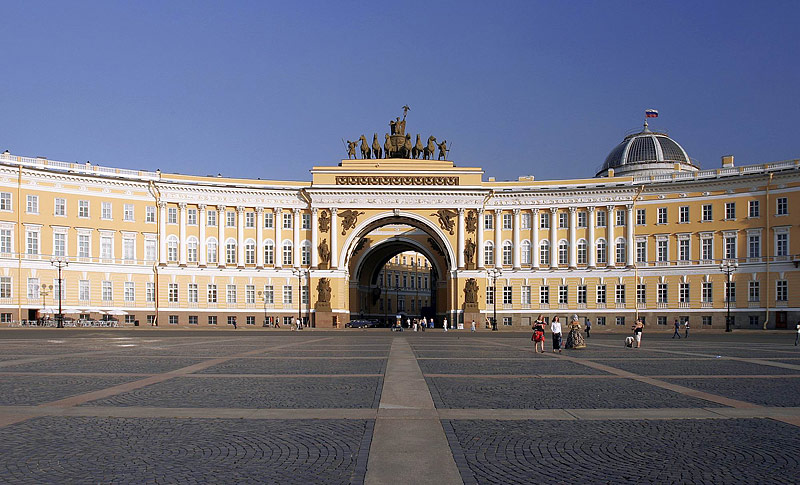
Practically unknown outside Russia, this Italian-born architect was the major creative force behind great swathes of central St. Petersburg, particularly the city’s grand formal squares, with their Empire-style columned facades and trademark yellow-and-white plasterwork. His most famous buildings include the General Staff Building on Palace Square, the Alexandrinsky Theatre, the Senate and Synod Building, and the Mikhailovsky Palace (the State Russian Museum). In the «Golden Triangle» of St. Petersburg’s historic centre, moreover, it’s hard to take more than a few steps without finding more of Rossi’s work.
Time
Optimal: Our walking tour of Rossi’s most famous buildings takes around 2.5 hours.
Minimum: You’ll see Rossi’s work when you visit the Hermitage, the State Russian Museum, the Bronze Horseman, and just about anywhere you walk in central St. Petersburg.
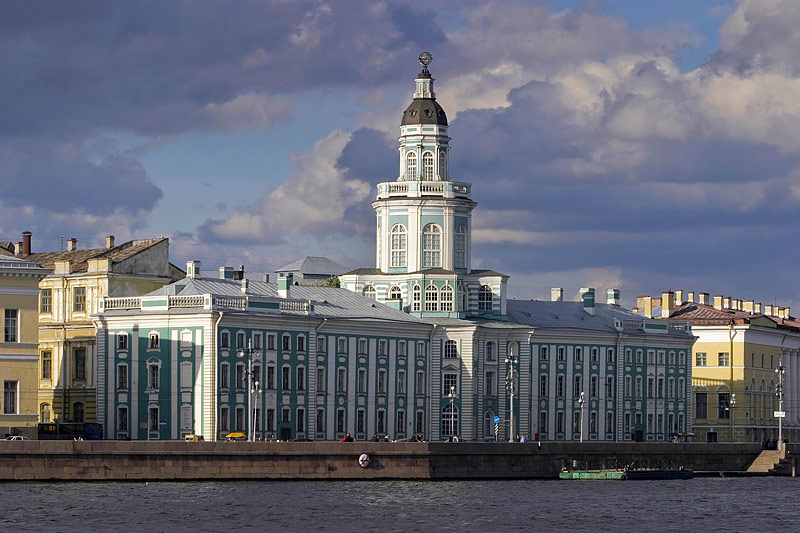
The city’s oldest museum, the Kunstkammer was founded in 1718 by Peter the Great himself, and is primarily of interest as a monument to the remarkable endeavours and enthusiasms of St. Petersburg’s extraordinary founder. Housed in an elegant baroque building on Vasilevskiy Island, the museum has a rather pedestrian collection of ethnographic exhibits, and most visitors are drawn rather to Peter’s own fascination, the huge number of deformed fetuses preserved in jars and other freaks of nature. Slightly less sensational but also of interest are the displays devoted to the great Russian polymath Mikhail Lomonosov.
Time
A visit to the Kunstkammer will take around 1.5 hours.
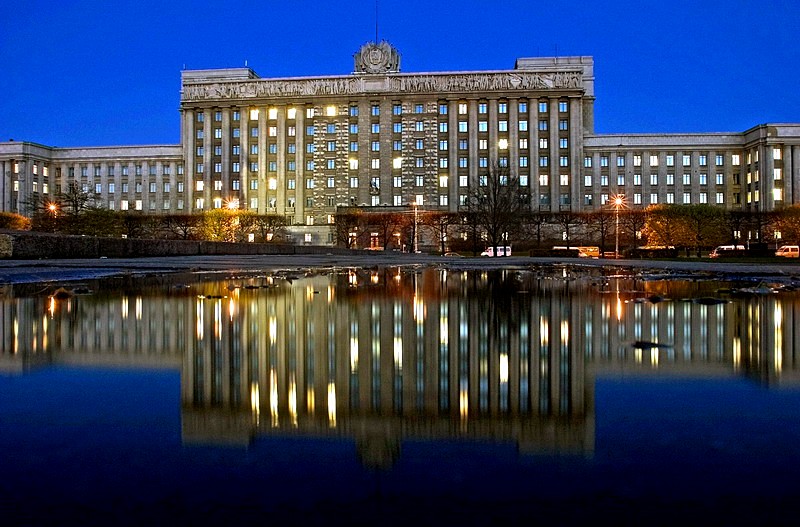
St. Petersburg’s historic centre is renowned for having undergone little architectural change during the 20th century. In fact, the Soviet authorities were inclined to abandon the centre, redolent of the imperial past, and develop a new city to the south, along Moskovsky Prospekt. Most visitors only see this part of town on their way to and from Pulkovo Airport, but its worth exploring for several fantastic examples of Stalin-era architecture, including the monumental House of Soviets, as well as the memorials to the Great Patriotic War in Park Pobedy («Victory Park») and on Ploshchad Pobedy («Victory Square»). The latter is home to a magnificent panoramic monument to the Heroic Defenders of Leningrad, which has a museum detailing the defense of the city beneath it.
Time
Optimal: It is worth spending a couple of hours exploring Moskovsky Prospekt southwards from Park Pobedy Metro Station, as well as taking a tour of the museum beneath the Monument to the Heroic Defenders of Leningrad.
Minimum: If you’re short of time, there’s not reason to make an extra trip out to Moskovsky Prospekt as you’ll be able to see the highlights on the way to/from the airport.
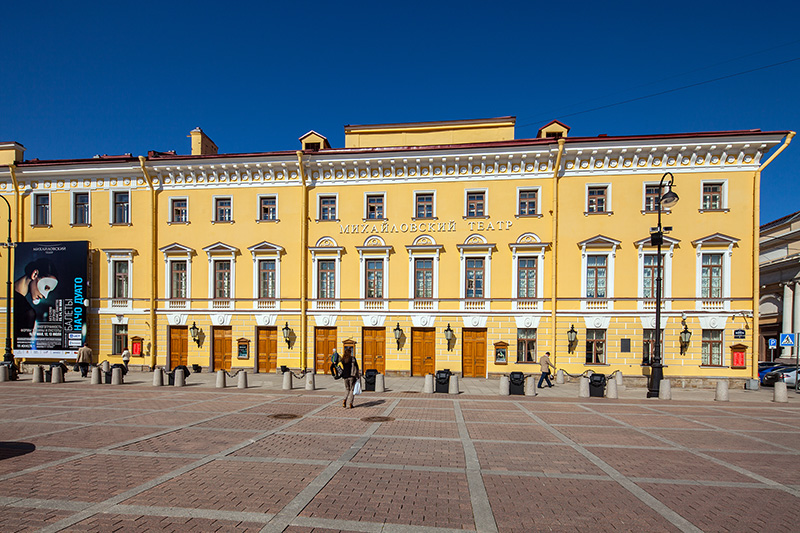
While there’s no questioning the Mariinsky Theatre’s position as St. Petersburg’s leading venue for opera and ballet performances, it is worth paying attention to this second historic theatre on Ploshchad Iskusstv, not only because of the last decade’s largely successful financial and artistic renaissance, which has seen the Mikhailovsky engage top foreign talent and gain an international reputation, but also because it can often be a more affordable and accessible way to see ballet in St. Petersburg. This is especially true when tickets at the Mariinsky are scarce during the White Nights Festival.
Time
Ballet enthusiasts should definitely consider taking in a show at the Mikhailovsky as an addition to, rather than a replacement for, performances at the Mariinsky.
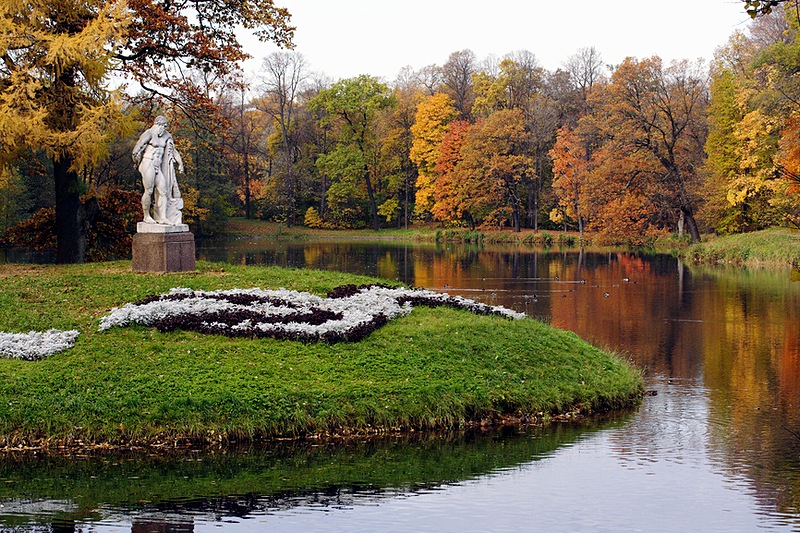
Accessible from the city centre in around 20 minutes by metro, Yelagin Island (also known by its Soviet-era name as the «Kirov Central Park of Culture and Leisure») rarely finds a place on tourist itineraries. It really should be more popular, however, offering not only a (comparatively) small but very elegant Imperial palace by Carlo Rossi, but also attractive parkland, a boating lake in summer and outdoor skating in winter, and the surprisingly avant-garde wonders of the Museum of Glass Art. The lack of cars on the island and the small entrance fee make it a secluded a tranquil spot, and its probably the best of the green spaces within the city if you’re looking for somewhere to enjoy a relaxing walk.
Time
Yelagin is a great place to while away a summer afternoon, and also has a fairly active calendar of cultural events in the warmer months, including a couple of music festivals.
Attractions of Saint -Petersburg
St. Petersburg is a Russian port city on the Baltic Sea. It was the imperial capital for 2 centuries, having been founded in 1703 by Peter the Great. The city remains Russia’s cultural center, with its world-famous museums, palaces and theatres.
The Hermitage is one of the largest and oldest museums in the world. It was founded by Catherine the Great. The museum includes masterpieces by Leonardo da Vinci, Picasso, Renoir, Vincent van Gogh, Rembrandt and many others. Experts say it would take 11 years to examine about 3 million exhibits in the Hermitage.
Nevsky Prospekt is the main street in St. Petersburg which was cut through thick woodland in 1718. Kazan Cathedral with its impressive colonnade is located just in the heart of the street. The prospect is lined with numerous cafes, restaurants and shops.
Church of the Saviour on the Spilled Blood with its colourful domes and bright mosaics was constructed in the early 20th century on the spot of the 1881 assassination of Tsar Alexander II. Used by the Soviets to store potatoes during the Second World War 900-day siege of the city by Nazi forces, the church was finally reopened to the public in 1997.
Peter and Paul Fortress was one of the first buildings to be erected in St Petersburg in 1703, including the Baroque Peter and Paul Cathedral, which is the final resting place of almost all of Russia’s pre-revolutionary leaders (Peter the Great, Catherine the Great, Nicholas II and others). Other sights include an impressive statue of Peter the Great named “The Bronze horseman”, a working mint and the cells where revolutionaries were held.
Mariinsky Theatre was first opened in 1860. The theatre has long been one of the world’s most prominent venues for ballet and opera. Its dance school trained such world-famous ballet dancers as Rudolf Nureyev and Vatslav Nijinsky.
While the State Hermitage displays fine art from all over the world, the Russian Museum contains home-grown masterpieces. Opened in 1898, the museum exhibits everything from priceless orthodox icons to paintings by such famous artists as Surikov, Vasnetsov, Aivazovsky, Kandinsky. Among outstanding works are “The Last Day of Pompeii” by Karl Bryullov, and Ilya Repin’s “The Zaporozhye Cossacks Writing a Letter to the Turkish Sultan”.
The gold-domed 19th-century St Isaac’s Cathedral is one of St Petersburg’s most famous landmarks. It offers wonderful views of the city from its gilded viewing platform. Statues of the apostles stand guard at the top of St Isaac’s, while its massive doors are decorated with biblical scenes. Inside, the cathedral boasts a vast ceiling painting by Karl Bryullov as well as St Catherine’s Chapel.
Vasilevskiy Island — the largest island in St Petersburg which offers a bizarre selection of attractions including a pair of 15th-century sphinxes from Egypt on the river side and a museum of biological oddities “Kunstkamera” where you can see the skeleton and the heart of Peter the Great’s gigantic personal servant. The island is also home to the 19th-century Rostral Columns whose torches are lit on special occasions. It’s a great place to wander along the banks of the Neva river.
Обновлено: 10.01.2023
It is so nice to travel around Russia one day. There are so many interesting places, old towns and villages, historical monuments and nice fountains. If I had a chance I would travel all my life. Traveling is my hobby.
The town I would like to start my travel with is Saint Petersburg. It’s an old and beautiful town with long and interesting history.
Saint Petersburg is a Russian port town. So many tourists from different countries come here almost every month. Every guest says that the city is beautiful pretty rainy and full of people. And it is really so.
Petersburg is a second largest city in Russia. Many people say that it is also the second capital. The town is located on Neva River and has more that 5 million inhabitants. There are many sights you can find here, because the city is pretty old.
State Hermitage — is a museum of art and culture was founded in 1764. It’s the second largest museum in the world.
Saint Isaac’s Cathedral is another place of interest. Currently that church functions as a museum. Few architectural styles are mixed in that building.
Peter and Paul fortress is also worth visiting. This beautiful fortress was founded in 1703. After some time the fortress was used as a prison.
Nevsky prospect is one of the teenagers’ favorite places, because of shopping. Every day hundred people come and spend here a lot of money. You can find all kind of boutiques, department stores, cafes and restaurants in this place.
There are so many interesting places in Saint Petersburg. Every street has some secrets or stories about Second World War. Also you will see some monuments here.
People come here during the whole year to see Savior on the Spilled Blood, Peterhof , Winter Palace, Palace Square and other places. There is always something to see here.
Достопримечательности Санкт-Петербурга
Было бы здорово объехать однажды всю Россию. Здесь столько интересных мест, старинных городов и деревень, исторических памятников и прекрасных фонтанов. Если мне повезёт, я обязательно отправлюсь в путешествие. Ведь путешествия- мое хобби.
А город, с которого я бы очень хотела начать — это Санкт-Петербург. Это старинный и красивый город с длинной и интересной историей.
Санкт-Петербург — это российский портовый город. Очень много туристов из различных стран приезжают сюда почти каждый месяц. И каждый говорит, что это красивый дождливый и полный гостей городок. И это на самом деле так.
Питер — второй по величине город в России. А многие говорят, что это вторая столица страны. Город расположен на реке Нева и насчитывает более 5 миллионов жителей. Здесь вы найдёте много достопримечательностей, ведь Питер достаточно старинный город.
Государственный Эрмитаж — музей искусства и культуры основан в 1764 году. Это второй по величине музей во всем мире.
Собор святого Исаака тоже является достопримечательностью города. В последнее время эта церковь является также музеем. Здание представляет собой микс архитектурных стилей.
Петропавловская крепость тоже достойна посещения. Эта красивая крепость была построена в 1703 году. А через некоторое время ее использовали как тюрьму.
Невский проспект — любимое место молодежи, ведь это центр шоппинга. Каждый день сотни людей приезжают сюда и тратят кучу денег. Здесь вы найдёте всевозможные бутики, торговые центры, кафе, рестораны.
В Санкт-Петербурге много хороших мест. Каждая улица таит свой секрет или какую-нибудь историю со времён Второй Мировой войны. Здесь сохранилось много памятников.
Люди приезжают сюда круглый год, чтобы увидеть Храм Спаса-на-Крови, Петергоф, Зимний Дворец, Дворцовую площадь и многое другое. Здесь всегда найдутся интересные достопримечательности.
My name is Anna and I’m 16 years old. I live in Rostov-on-Don, which is a large city in the south region of Russia. My family is not big. It’s just me, my parents and my grandpa.
The school, which I attend, is situated in a walking distance from us. My teacher, Alissa Ivanovna, often organizes school trips to other cities. Last year, we went to Saint-Petersburg for three days. It was during the holidays in May. Since then, I fell in love with this city. I’ve realized that it’s the most beautiful place I’ve ever seen.
I know that there are many other nice cities in our country and abroad, but none as charming as Saint-Petersburg. Perhaps, the first thing that I noticed, when we arrived, was the unique architecture. The second eye-catching thing is the abundance of bridges across the river Neva. I can hardly distinguish which building or bridge was the best, as they are all magnificent. The Winter Palace was undoubtedly one of the most beautiful structures. I also liked the Nikolaevskiy Palace and the Savior on the Spilled Blood Cathedral.
I regret that we had so little time to see all the sights, but we managed to visit Peterhof, which reminded me a kingdom of fountains, and Tsarskoe Selo. Peterhof was built on the orders of Peter the Great — the remarkable person, who ruled the country in the 17th and 18th centuries. Saint-Petersburg was even named after him and all the glorious architecture, which can now be seen in the city, is his merit. During his reign, best European masters were invited to erect the palaces, cathedrals, mansions, bridges and noble monuments. Unfortunately, we didn’t see the famous White Nights of Saint Petersburg, as they take place in June. But that’s a good reason to visit my favourite city one more time.
Мой любимый город
Меня зовут Анна и мне 16 лет. Я живу в большом городе в южном регионе России, в Ростове-на-Дону. Моя семья небольшая. В ней всего лишь я, мои родители и мой дедушка.
Школа, которую я посещаю, расположена в нескольких минутах ходьбы от нас. Моя учительница, Алиса Ивановна, часто организует школьные экскурсии в другие города. В прошлом году, мы поехали на три дня в Санкт-Петербург. Это было во время майских праздников. С тех пор я просто влюбилась в этот город. Я поняла, что это самое красивое место, которое я когда-либо видела.
Я знаю, что в нашей стране, равно как и за рубежом, есть много других симпатичных городов, но, ни один из них не имеет очарования Санкт-Петербурга. Возможно, первое, на что я обратила внимание, когда мы прибыли, это уникальная архитектура. Второе, что бросается в глаза, это обилие мостов через Неву. Мне сложно выделить какое-то одно здание или мост, так как они все великолепны. Зимний дворец был, несомненно, одним из самых красивых зданий. Мне также понравились Николаевский дворец и Храм Спаса-на-Крови.
Жаль, что у нас было так мало времени на осмотр всех достопримечательностей, но нам удалось посетить Петергоф, который напоминает царство фонтанов, и Царского Село. Петергоф был построен по приказу Петра Великого — выдающегося человека, который правил страной в 17 и 18 веках. Санкт-Петербург был даже назван в его честь, и вся чудесная архитектура, которую в настоящее время можно увидеть в городе, это его заслуга. Во время его правления, лучшие европейские мастера были приглашены для возведения дворцов, соборов, особняков, мостов и величественных памятников.
К сожалению, мы не застали знаменитые белые ночи Санкт-Петербурга, так как они происходят в июне. Но это хороший повод посетить мой любимый город еще раз.
Сохранить эту страницу в социальной сети:
Англо-русский словарь онлайн
5 тестов скорости!
на английском языке с переводом на русский язык
Saint Petersburg
Санкт-Петербург
Saint Petersburg is a beautiful Russian city with rich history. Its unique architectural ensemble reflecting Russian, European and even ancient Roman traditions could astonish everyone, as well as fascinating bridges and canals (sometimes it is called “the Northern Venice”). Saint Petersburg is the second largest city in Russia (over 5 million people live there) and, as an important economic, transport, and cultural center, is included, along with Moscow, in the number of federal cities. Its third name is “the Northern capital”: although Saint Petersburg lost the status of capital in 1918, it still plays a great role in the country’s life.
Город был основан в XVIII в. по приказу Петра I и стал символом новорождённой Российской Империи. Кроме того, он был стратегически значим как выход в Балтийское море и база российского военного флота. Впоследствии развитие Санкт-Петербурга было связано с укреплением империи: на протяжении двух веков он оставался центром государственного управления, армии, светской жизни и культуры, особенно литературы (Пушкин, Гоголь, Достоевский создали там свои шедевры). Город пережил три революции и трагическую блокаду (в ходе Великой Отечественной войны), но сохранил свою красоту и славу.
There are many landmarks for any taste in Saint Petersburg: Hermitage, a huge museum with extremely valuable collection of painting and sculpture; Peterhof, a monumental complex of imperial palaces, gardens and fountains; Mariinsky Theater, one of the best opera and ballet theaters in the world; the main street, Nevsky Prospect, full of historical places and shops… Therefore, Saint Petersburg attracts thousands of tourists every year.
В Санкт-Петербурге много достопримечательностей на любой вкус: Эрмитаж, колоссальный музей с чрезвычайно ценной коллекцией живописи и скульптуры; Петергоф, монументальный комплекс императорских дворцов, садов и фонтанов; Мариинский театр, один из лучших оперных и балетных театров в мире; главная улица, Невский проспект, полная исторических мест и магазинов… Поэтому каждый год Санкт-Петербург привлекает тысячи туристов.
Дорогой ученик! В этом материале подготовлено описание достопримечательностей Санкт-Петербурга🇷🇺. Под английским текстом есть перевод на русский язык.
Palace Square
Palace square is the main square of Saint Petersburg. The square is a pedestrian area.
A lot of famous architectural monuments, such as the Winter Palace, the General Staff Building with a triumphal arch and the Alexander Column are located there.
The Hermitage
The Hermitage is one of the world’s largest museums. It is located in Saint Petersburg. It consists of 5 buildings. The museum’s collection houses about 3 million different works of art.
From the very beginning the Hermitage was Catherine’s II private collection of paintings, but in the time of Nicholas I the Hermitage opened for general public. This happened in 1852.
The Mariinsky Theatre
The Mariinsky Theatre is one the most famous theatres in Russia. The theatre was named after Maria Alexandrovna, wife of Tsar Alexander II.
The first theatre season opened on 2 October 1860. The theatre is the home to the Mariinsky Ballet, Mariinsky Orchestra and Mariinsky Opera.
The Bronze Horseman
The Bronze Horseman is the statue of Peter the Great. It is located in the Senate Square. The statue was unveiled in 1782. The statue itself is about 5.35 m tall , while the pedestal is another 5.1 m tall , for a total of approximately 10.4 m .
Peter the Great sits on his horse facing towards the Neva River. The horse tramples a serpent which symbolizes envy and hostile forces.
The Church of the Saviour on Spilled Blood
The Church of the Saviour on Spilled Blood is located in the centre of Saint Petersburg. It is built on the site where in 1881 Emperor Alexander II was fatally wounded.
It took 24 years (from 1883 to 1907) to build the church. Today the church is a popular tourist attraction and a museum of mosaics.
Petergof
Petergof is a small town which has great tourist and scientific significance. In the XVIII century the emperor’s country residence was located there.
The town is located not far from Saint Petersburg and is well-known for its landmarks. These places of interest include the palace ensemble called Petergof with its numerous fountains, alleys and the Peterhof Grand Palace.
Nevsky Prospect
Nevsky Prospect is the main street of Saint Petersburg. It is 4,5 km long . Nevsky Prospect connects the Admiralty and the Alexander Nevsky Lavra. A lot of famous buildings are located there.
In the past the street played an important strategic role in the life of the city. Nowadays it is a lively place with lots of shops and entertainment.
The Peter and Paul Fortress
Construction of the fortress started in 1703. The fortress has never been used for military purposes. It was used as a prison for political figures. A. Radishchev, F. Dostoevsky, N. Chernyshevsky and many others endured their punishment there. In 1924 the fortress was converted to a museum.
Kazan Cathedral
Kazan Cathedral is one of the biggest cathedrals in Saint Petersburg. It is located on Nevsky Prospeсt. Cathedral is a memorial to Russian military glory. It took 10 years (from 1801 to 1811) to build Kazan Cathedral.
In 1813 Mikhail Kutuzov, a well-known commander, was buried on its territory. Right in front of Kazan Cathedral there is the statue of Mikhail Kutuzov.
Saint Isaac’s Cathedral
Saint Isaac’s Cathedral is located in Saint Petersburg. It is one of the largest cathedrals in the world. The construction of the cathedral took 40 years .
The height of the cathedral is 101,5 metres . The exterior of the cathedral features a lot of columns and statues.
Nowadays, Saint Isaac’s Cathedral is a museum. However, services are conducted there on feast days.
Перевод на русский язык
Достопримечательности Санкт-Петербурга
Дворцовая площадь
Дворцовая площадь – главная площадь Санкт-Петербурга. Она является пешеходной зоной.
На ней расположены многие известные памятники архитектуры, такие как Зимний Дворец, Здание главного штаба с триумфальной аркой, а также Александровская колонна .
Мариинский театр
Мариинский театр – один из самых известных театров России и мира. Театр был назван в честь Марии Александровны, супруги Александра II.
Первый театральный сезон открылся 2 октября 1860 года. Театр включает в себя Мариинский балет, Мариинский оркестр и Мариинскую оперу.
Эрмитаж
Эрмитаж – один из крупнейших музеев мира. Он находится в Санкт-Петербурге. Он состоит из 5 зданий. Коллекция музея насчитывает около 3 миллионов различных произведений искусства.
Изначально Эрмитаж был частной коллекцией картин Екатерины II, но во времена Николая I Эрмитаж был открыт для широкой публики. Это случилось в 1852 году.
Медный всадник
Медный всадник – это памятник Петру I. Он находится на Сенатской площади. Его открытие состоялось в 1782 году. Высота самой статуи около 5.35 м , пьедестала – еще 5.1 м , а общая высота составляет около 10.4 м .
Петр I сидит верхом на своем коне, повернувшись лицом к реке Нева. Лошадь растаптывает змею, которая символизирует зависть и враждебные силы.
Храм Спаса на Крови
Храм спаса на Крови находится в центре Санкт-Петербурга. Он сооружен на месте, где в 1881 году был смертельно ранен император Александр II.
Строительство храма длилось 24 года (с 1883 по 1907 год). Сегодня церковь является популярной туристической достопримечательностью и музеем мозаики.
Петергоф
Петергоф – небольшой городок, имеющий огромное туристическое и научное значение. В XVIII веке здесь находилась загородная резиденция императора.
Город расположен неподалеку от Санкт-Петербурга и знаменит своими достопримечательностями. В их число входит дворцовый ансамбль Петергоф с многочисленными фонтанами, аллеями и Большим Петергофским дворцом.
Невский проспект
Невский проспект – главная улица Санкт-Петербурга. Протяженность улицы составляет 4,5 км . Невский проспект соединяет Адмиралтейство и Александро-Невскую лавру. На нем расположены многие известные здания.
В прошлом улица играла важную стратегическую роль в жизни города. Сегодня проспект – оживленное место с большим количеством магазинов и развлечений.
Петропавловская крепость
Строительство крепости началось в 1703 году. Крепость никогда не использовалась в военных целях. Она служила тюрьмой для политических деятелей. А. Радищев, Ф. Достоевский, Н. Чернышевский и многие другие отбывали свое наказание там. В 1924 году крепость стала музеем.
Казанский собор
Казанский собор является одним из крупнейших храмов Санкт-Петербурга. Он находится на Невском проспекте. Собор представляет собой памятник русской воинской славе. Его строительство заняло 10 лет (с 1801 по 1811 год).
В 1813 году на его территории был похоронен известный полководец М. И. Кутузов. Перед Казанским собором стоит памятник М. И. Кутузову.
Исаакиевский собор
Исаакиевский собор находится в Санкт-Петербурге. Он является одним из крупнейших соборов мира. Строительство собора заняло 40 лет .
Высота собора составляет 101,5 метра . Во внешней отделке собора присутствуют многочисленные колонны и статуи.
Сегодня Исаакиевский собор – это музей. Однако, по праздникам здесь проходят службы.
Топик по английскому языку Санкт-Петербург (Saint Petersburg) поможет Вам рассказать об этом прекрасном городе с огромным количеством достопримечательностей. Изучив топик по английскому языку Санкт-Петербург вы ознакомитесь с историей этого удивительного города. Топик по английскому Санкт-Петербург будет полезен не только его жителям, но и тем, кто хотел бы поделиться впечатлениями о поездке в Санкт-Петербург или только планирует его посетить. Изучив топик по английскому Санкт-Петербург вы научитесь рассказывать о том, чем знаменит Петербург, сможете рассказать о своих любимых местах в этом городе, что пригодится при общении не только с жителями этого города, но и с иностранцами.
Saint-Petersburg one of the most beautiful cities of the world. It is the second largest Russian city after Moscow. Peter the Great cut a “window to Europe” by founding Saint Petersburg in 1703. People were brought from all parts of Russia to build a new city on the swampy land on the Neva River.
In 1917 St. Petersburg with its palaces, churches, cathedrals and government buildings became the capital of Russia and grew rapidly. Architects came from Europe to make Saint Petersburg one of the most wonderful cities.
Buildings were constructed of granite and were grey and rose-coloured. The Winter Palace and the Hermitage Palace were equal to any monarch`s residence in Europe. In 1914, when the First World War began, the name Saint Petersburg was changed to Petrograd, because it sounded German. In 1924, the city was renamed to Leningrad and in 1991 back to Saint Petersburg.
The city suffered a great deal during the Great Patriotic War. It was cut off the rest of the country for almost 900 days. People died starvation; many buildings were destroyed. It took many years to rebuild the city.
Today St Petersburg is an important cultural, industrial and educational center. The population of the city is over 5 million people.
Saint Petersburg is a wonderful city, its sightseeings are unforgettable: the Russian Museum, The Winter Palace, St Isaac’s Cathedral, the Hermitage, the Peter-and-Paul Fortress and the Admiralty building attract of tourists from every corner of the world. Petersburg’s museums house famous collections, for example, the Hermitage contains one of the richest collections of pictures in the world.
Saint Petersburg is also called the Northern Venice. There are 65 rivers and canals there. The bridges over the rivers are artistically decorated. The city is also famous for its white nights.
В 1917 году Петербург с его дворцами, церквями, соборами и правительственными зданиями стал столицей России и быстро разросся. Архитекторы приезжали из Европы, чтобы сделать Санкт-Петербург одним из прекраснейших городов.
Здания строились из гранита и были серого и розового цветов. Зимний Дворец и Эрмитаж ни в чем не уступали резиденциям европейских монархов. В 1914 году, когда началась Первая Мировая Война, название Санкт-Петербург было изменено на Петроград, из-за немецкого звучания. В 1924 году город был переименован в Ленинград, а в 1991 году снова в Санкт-Петербург.
Город сильно пострадал во время Великой Отечественной Войны. Он был отрезан от страны почти на 900 дней. Люди умирали от голода, многие здания были разрушены. Ушло много лет на то, чтобы восстановить город.
Сегодня Санкт-Петербург является важным культурным, промышленным и образовательным центром. Население его более 5 миллионов жителей.
Санкт-Петербург прекрасный город, его достопримечательности незабываемы: Русский музей, Зимний дворец, Исаакиевский собор, Эрмитаж, Петропавловская крепость, Адмиралтейство привлекают туристов с разных уголков мира. В музеях Петербурга хранятся самые известные коллекции, например, в Эрмитаже находится одна из самых богатых коллекций картин в мире.
Санкт-Петербург так же называют Северной Венецией. Здесь 65 рек и каналов. Мосты через реки художественно оформлены. Город так де известен своими белыми ночами.
Читайте также:
- Урок сочинение по картине баян 9 класс по русскому языку
- Сочинение на тему роль морали в жизни общества
- Лермонтов из школьных сочинений
- Плакат как итоговое сочинение пройдет в 2021 22 учебном году
- Сочинение по пословице как ты относишься к лесу так и лес к тебе

